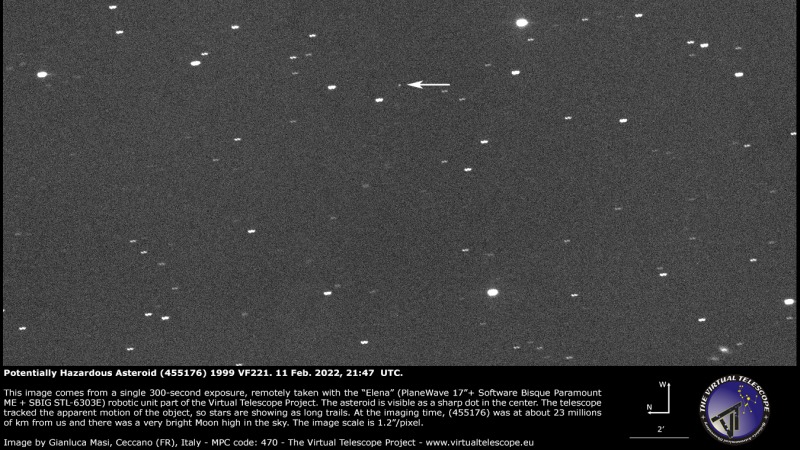A large asteroid zips past Earth today, here's how to watch it live
The webcast starts Monday (Feb. 21) at 7 p.m. EST.
The Virtual Telescope Project will provide a livestream Monday (Feb. 21) of an asteroid zooming safely past Earth, weather permitting.
You can catch live views of asteroid 1999 VF22 starting at 7 p.m. EST Monday (0000 GMT on Tuesday, Feb. 22) from Rome, Italy, where the project is situated. You can watch the livestream on this page or directly from the Virtual Telescope Project if weather conditions allow.
"The Virtual Telescope Project will show it live, online, just before the fly-by time. This way, you can join the journey from the comfort of your home," founder Gianluca Masi said in a statement.
Related: Just how many threatening asteroids are there? It's complicated.

The asteroid was discovered in 1999 by the Catalina Sky Survey, according to NASA's Jet Propulsion Laboratory's Small-Body Database. NASA has a mandate from Congress to seek out rocks that are potentially hazardous to Earth, and so far has found no imminent threats after decades of careful searching.
While 1999 VF22 is classified as "potentially hazardous," on this pass it will come relatively far away from our planet. Its closest approach will be roughly 3.3 million miles (5.4 million kilometers), the equivalent of 14 times the average lunar distance, according to Masi.
The asteroid has an estimated size of 1,017 feet (310 meters) in diameter and orbits the sun every 1.5 years, according to EarthSky. Astronomers are also using the Goldstone Radar Antenna in California to observe the space rock between Feb. 19 and 24, EarthSky said.
Get the Space.com Newsletter
Breaking space news, the latest updates on rocket launches, skywatching events and more!
Masi also captured an image of the asteroid on Feb. 11 during a 300-second exposure remotely taken using a PlaneWave 17-inch telescope. During the image exposure time, he said, the asteroid was approaching Earth from a distance of 22 million miles (35 million km).
If you're looking for binoculars or a telescope to see the asteroid in the night sky, check out our guide for the best binocular deals and the best telescope deals now. If you need equipment to capture the moment, consider our guides for the best cameras for astrophotography and the best lenses for astrophotography to make sure you're ready for the next asteroid sighting.
Follow Elizabeth Howell on Twitter @howellspace. Follow us on Twitter @Spacedotcom and on Facebook.
Join our Space Forums to keep talking space on the latest missions, night sky and more! And if you have a news tip, correction or comment, let us know at: community@space.com.

Elizabeth Howell (she/her), Ph.D., was a staff writer in the spaceflight channel between 2022 and 2024 specializing in Canadian space news. She was contributing writer for Space.com for 10 years from 2012 to 2024. Elizabeth's reporting includes multiple exclusives with the White House, leading world coverage about a lost-and-found space tomato on the International Space Station, witnessing five human spaceflight launches on two continents, flying parabolic, working inside a spacesuit, and participating in a simulated Mars mission. Her latest book, "Why Am I Taller?" (ECW Press, 2022) is co-written with astronaut Dave Williams.









